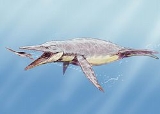
Brachauchenius
Encyclopedia
Brachauchenius is an extinct genus
of pliosaur
that lived in America (USA and Colombia
) during the Cretaceous
.
The type species, Brachauchenius lucasi, lived in the Western Inland Sea of North America around 93.5-89.3 million years ago, during the Turonian
stage of the Cretaceous
. An older specimen referred to Brachauchenius from the Barremian
of Colombia represents the first re-occurrence of the non-rhomaleosaurid pliosaurs after a Berriasian-Hauterivian hiatus.
The first known (type
) specimen (USNM 4989) was collected by Charles H. Sternberg from Ottawa County, Kansas in 1884. It had a skull length of about 90 cm. The species was named by S.W. Williston
. A larger specimen (FHSM VP-321 - skull length 170 cm) was collected by George F. Sternberg in 1952 from the Fairport Chalk of Russell County, Kansas, and later described by Carpenter. Schumacher and Everhart (2005) reported on the age and locality of both Kansas specimens. This pliosaur grew to around 10 meters (30 ft) in length. Brachauchenius represents the last known occurrence of a pliosaur in North America.
Genus
In biology, a genus is a low-level taxonomic rank used in the biological classification of living and fossil organisms, which is an example of definition by genus and differentia...
of pliosaur
Pliosaur
Pliosauroidea is an extinct clade of marine reptiles. Pliosauroids, also commonly known as pliosaurs, are known from the Jurassic and Cretaceous Periods. The pliosauroids were short-necked plesiosaurs with large heads and massive toothed jaws. These swimming reptiles were not dinosaurs but distant...
that lived in America (USA and Colombia
Colombia
Colombia, officially the Republic of Colombia , is a unitary constitutional republic comprising thirty-two departments. The country is located in northwestern South America, bordered to the east by Venezuela and Brazil; to the south by Ecuador and Peru; to the north by the Caribbean Sea; to the...
) during the Cretaceous
Cretaceous
The Cretaceous , derived from the Latin "creta" , usually abbreviated K for its German translation Kreide , is a geologic period and system from circa to million years ago. In the geologic timescale, the Cretaceous follows the Jurassic period and is followed by the Paleogene period of the...
.
The type species, Brachauchenius lucasi, lived in the Western Inland Sea of North America around 93.5-89.3 million years ago, during the Turonian
Turonian
The Turonian is, in the ICS' geologic timescale, the second age in the Late Cretaceous epoch, or a stage in the Upper Cretaceous series. It spans the time between 93.5 ± 0.8 Ma and 89.3 ± 1 Ma...
stage of the Cretaceous
Cretaceous
The Cretaceous , derived from the Latin "creta" , usually abbreviated K for its German translation Kreide , is a geologic period and system from circa to million years ago. In the geologic timescale, the Cretaceous follows the Jurassic period and is followed by the Paleogene period of the...
. An older specimen referred to Brachauchenius from the Barremian
Barremian
The Barremian is an age in the geologic timescale between 130.0 ± 1.5 Ma and 125.0 ± 1.0 Ma). It is a subdivision of the Early Cretaceous epoch...
of Colombia represents the first re-occurrence of the non-rhomaleosaurid pliosaurs after a Berriasian-Hauterivian hiatus.
The first known (type
Type species
In biological nomenclature, a type species is both a concept and a practical system which is used in the classification and nomenclature of animals and plants. The value of a "type species" lies in the fact that it makes clear what is meant by a particular genus name. A type species is the species...
) specimen (USNM 4989) was collected by Charles H. Sternberg from Ottawa County, Kansas in 1884. It had a skull length of about 90 cm. The species was named by S.W. Williston
. A larger specimen (FHSM VP-321 - skull length 170 cm) was collected by George F. Sternberg in 1952 from the Fairport Chalk of Russell County, Kansas, and later described by Carpenter. Schumacher and Everhart (2005) reported on the age and locality of both Kansas specimens. This pliosaur grew to around 10 meters (30 ft) in length. Brachauchenius represents the last known occurrence of a pliosaur in North America.

